Anomaly detection
Anomaly, or outlier detection, is the process of identifying events or data points that exhibit a significant deviation from the standard or expected behavior. Identifying the outliers in the data serves as an early indicator for various scenarios, helping executives and analysts find potential issues if any, capitalize on successful strategies, or understand external factors that contribute to better performance.
Zoho Analytics deploys robust machine learning algorithms like RPCA (Robust Principal Component Analysis) and various statistical models for detecting the outliers. This feature is highly customizable according to the distribution of the data.
- Business use cases
- Points to note
- Applying anomaly detection to data
- Information about the anomalies
- Machine learning model - RPCA (Robust Principal Component Analysis)
- Statistical models
Business use cases
- E-commerce: It helps businesses understand the reasons behind a sudden spike or drop in sales. An increased cart abandonment rate in a short period of time can signal issues with the websites while checking out.
- Marketing: It can be used to understand the underlying reasons that lead to increased or decreased website traffic or signups.
- Help desk: It can be used to identify sudden spikes in support ticket submissions or issues related to a specific product that may require attention.
- Security Threat Detection: For cybersecurity, anomaly detection is essential for identifying unusual network activities or patterns that may indicate a security threat.
Points to note
- Anomaly detection is supported for columns of numeric data type.
- The RPCA model requires a minimum of 6 data points and statistical model requires a minimum of 7 data points to identify anomalies.
- Anomaly or outlier detection is supported for all types of line and bar charts.
- An anomaly can be applied for multiple Y-axes.
Applying anomaly detection to data
- Open the required chart for which you need to spot anomalies.
Click the Analysis button and choose Anomaly / Outliner option.
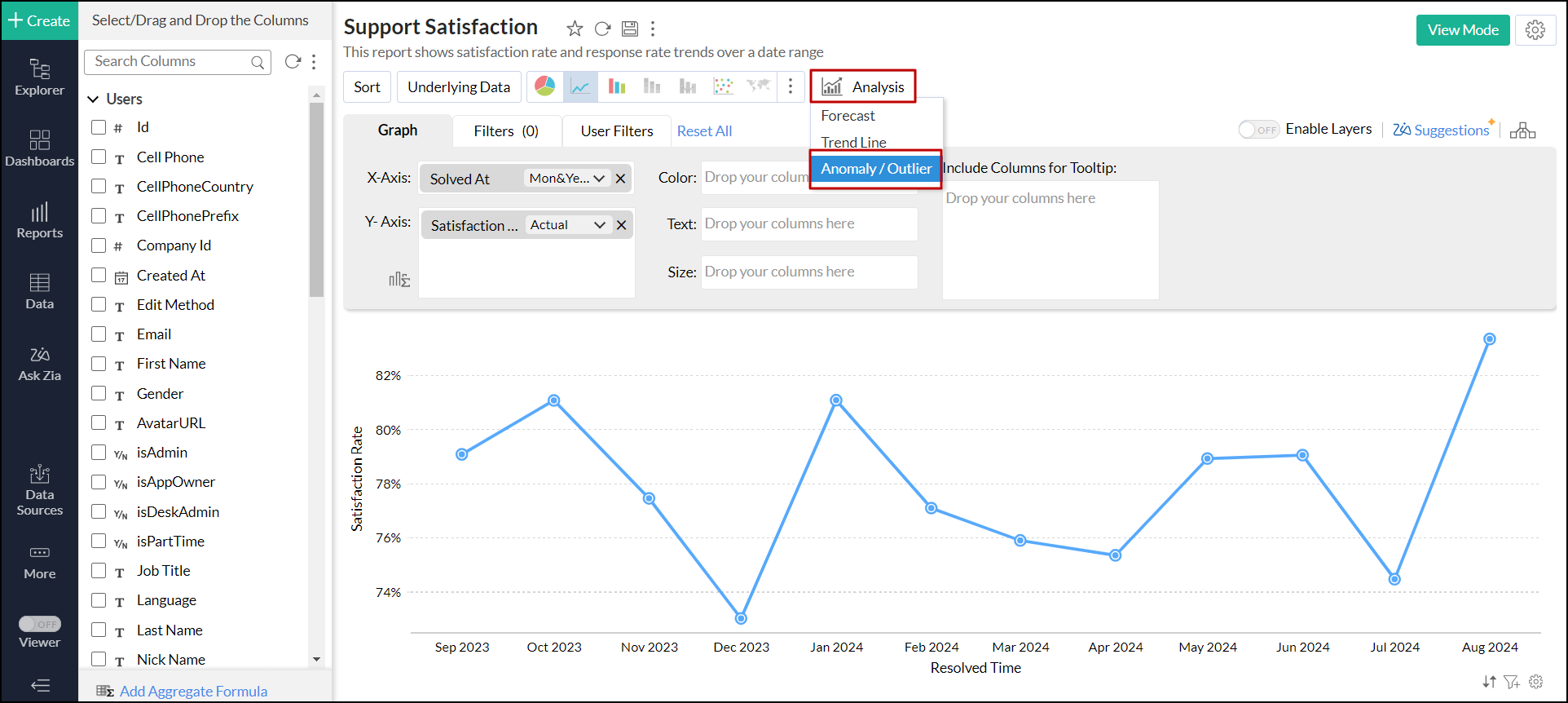
Or you can click the Settings icon and navigate to the Anomaly / Outliner tab.
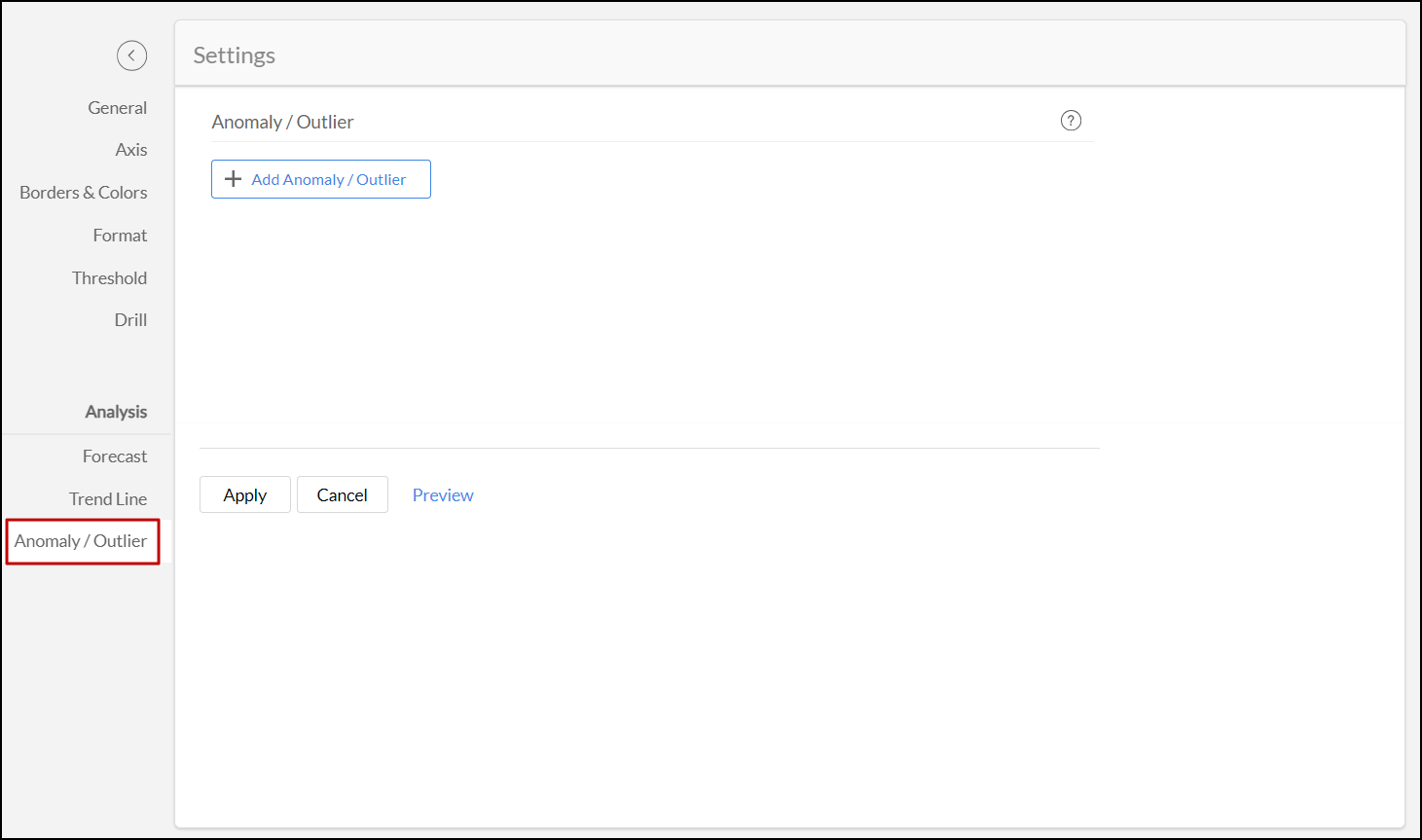
- In the dialog/ page that appears, click the + Add Anomaly / Outlier button.
- Select the columns for which the anomalies should be detected.
- Provide a name of the anomaly.
- Select the Model that should be used for detecting the outliers. Refer to the Models sections to learn how to choose the models based on the data.
- Select the Direction (Above, Below) to identify anomalies within the specific boundaries. By default, anomalies are identified in Both directions.
RPCA Model: Adjust the Deviation Percentage of the RPCA model if needed. Decreasing the deviation percentage makes the data more sensitive, and even a slight deviation is marked as an outlier. Increasing the deviation percentage reduces the sensitivity, making it more selective in finding the outliers. 70% is set as the default deviation percentage for this model.
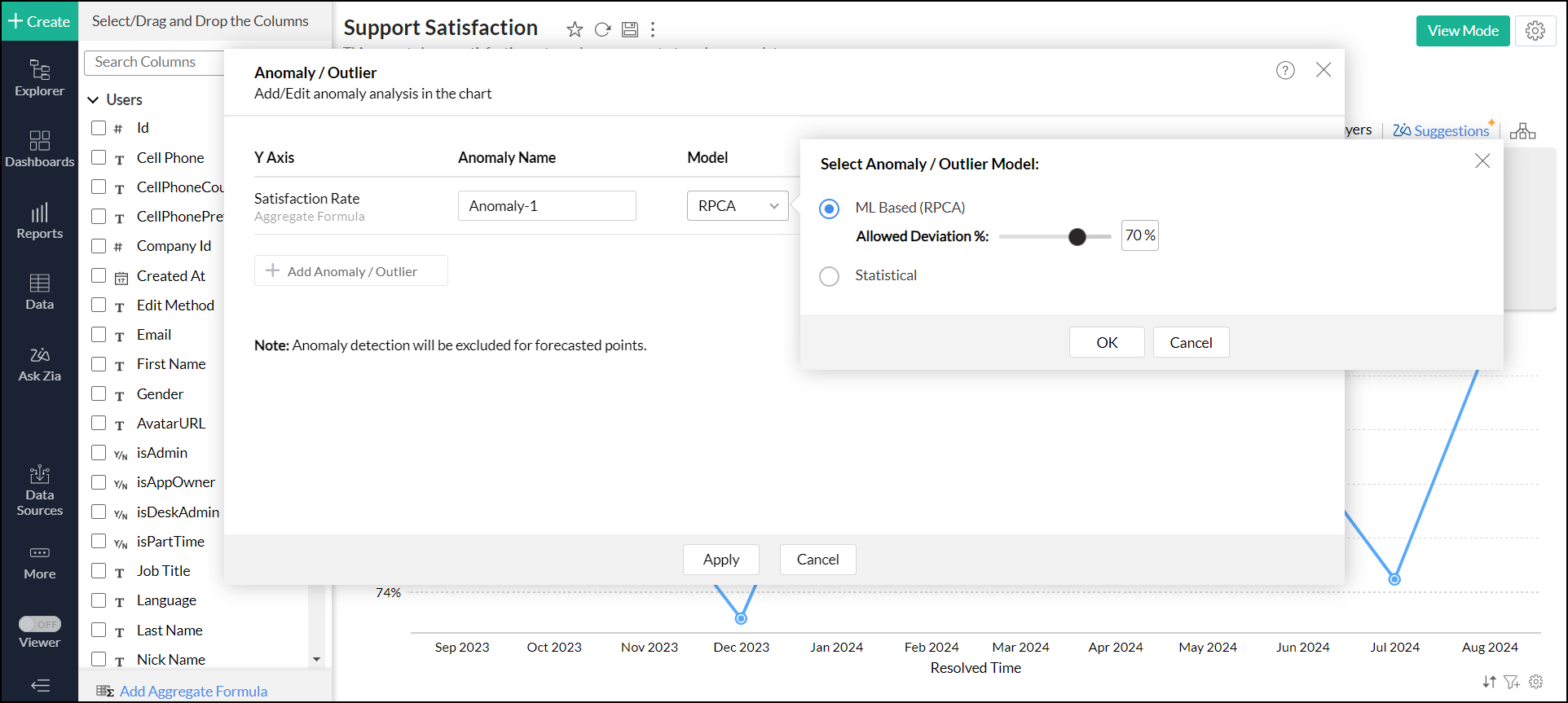
Statistical Models: Choose the statistical model and the threshold that should be used to identify the outliers. Click here to learn how to choose the statistical model based on the data distribution.
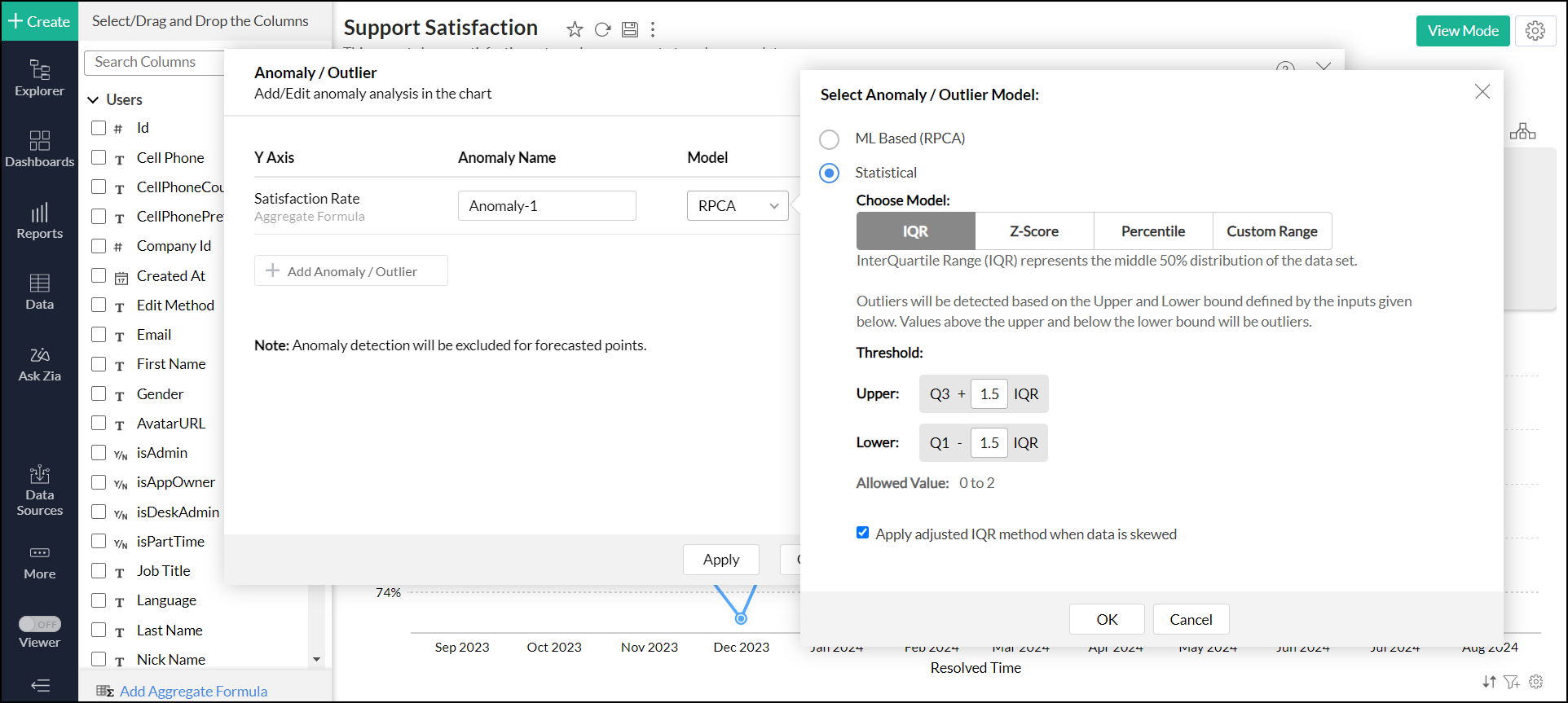
- While choosing the direction, the threshold options will be available based on the directions
- Above: When the Above Direction option is chosen, the upper threshold configuration alone will be displayed for the statistical models.
- Below: When the Below Direction option is chosen, the lower threshold configuration alone will be displayed for the statistical models.
Customize the Marker Shape, Size, and Color as needed. Varied colors can be used to differentiate the upper and the lower anomalies.
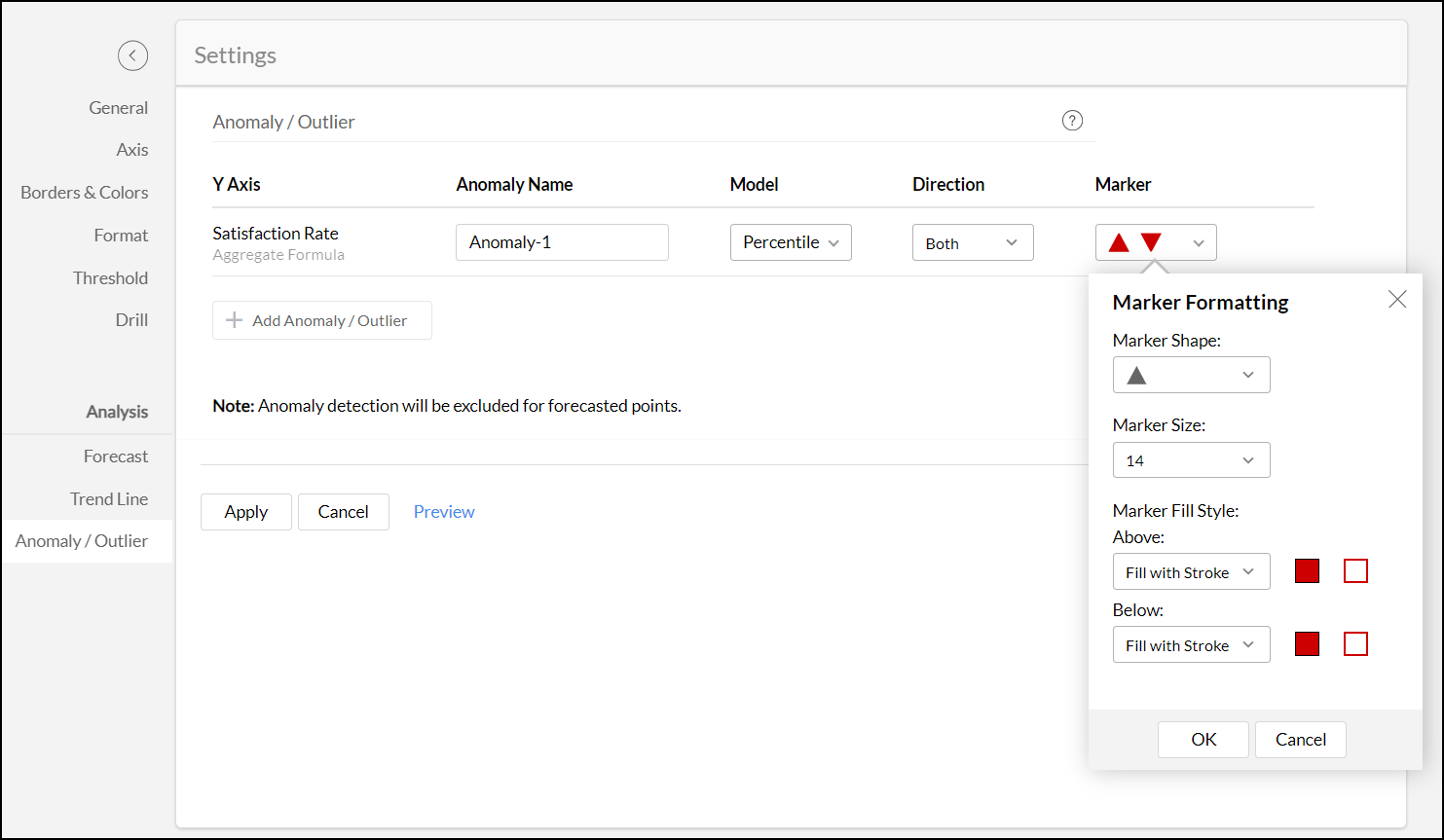
- Click Apply.
Information about the anomalies
The data points that are identified as outliers will be marked in red. Upon clicking on these marked data points, detailed information about the anomalies will be displayed.

- Expected value - The Y-value computed by the selected anomaly detection methods for the underlying X-value.
- Difference - The difference between the actual value of an anomaly and its expected value.
- Deviation Percentage - Percentage of the deviation over the expected value.
Machine learning model - RPCA (Robust Principal Component Analysis)
This model is capable of accurately identifying anomalies in a single-variable dataset within time-series data, considering both seasonal patterns and temporal aspects. The algorithm in this model identifies anomalies based on the allowed deviation percentage. By adjusting the deviation percentage, the algorithm can detect anomalies that exhibit significant deviations. The range of deviation can vary from 0% to 95%. 70% would be considered as by default allowed deviation percentage.
This method is best suitable for detecting anomalies on aggregated measures over time-series values.
Statistical Models
Interquartile Range
IQR - The interquartile range (IQR) is a measure of statistical dispersion that describes the range within which the middle 50% of a data set falls. The Outliers are calculated based on this range.
The IQR is calculated as the difference between the third quartile (Q3) and the first quartile (Q1). The default scale value of 1.5 is multiplied by the IQR to determine the upper and lower boundaries (thresholds). The threshold values can be adjusted based on the distribution of the data.
For data with a skewed distribution, the adjusted IQR method will be applied.
Z-Score
The Z-score determines how far a data point is from the mean of the dataset in terms of standard deviations. By default, a data point will be marked as an outlier if the Z-score is more than 3 standard deviations.
A Z-score of ±3 is often set as a threshold for detecting the outliers. This means that data points falling beyond 3 standard deviations from the mean in either direction (to the left or right) are considered outliers. The thresholds can be adjusted based on the distribution of the data.
For data with a skewed distribution, the modified Z-score method will be applied. The Z-score is calculated based on the Median Absolute Deviation method.
Percentile
A percentile is a statistical measure that represents the relative position of a particular value within a dataset. Percentiles divide the data into 100 equal parts, and the value at each percentile indicates the percentage of values that are equal to or below a given value. Outliers will be determined based on the percentile value.
The 5th and 95th percentiles are set as the default values for the upper and lower bound. The threshold values can be changed based on the specific characteristics of the data.
Custom Range
In this method, the upper bound and the lower bound are any particular values from the dataset. The outliers are calculated based on the thresholds.




